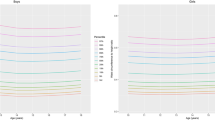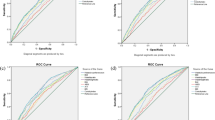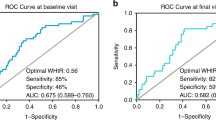Abstract
OBJECTIVE:
To compare waist circumference (a measure of central fatness) and body mass index (BMI, a measure of general fatness) between a contemporary cohort and similar aged British children measured in 1987.
DESIGN:
Comparative study of two cohorts. The first was a cross-sectional survey and the second an ongoing longitudinal survey.
SETTING:
The cross-sectional study was conducted throughout Great Britain during 1987. The ongoing longitudinal study was conducted in the Avon region between 1995 and 1998.
PARTICIPANTS:
A total of 1821 children were measured in the cross-sectional study, and around 1000 children were measured in the longitudinal study. Ages ranged between 2 and 5 y.
MAIN OUTCOME MEASURES:
Waist circumference, height, weight and BMI. Values were expressed as mean±s.d. Age-related measures were compared.
RESULTS:
At equivalent ages, mean waist circumference values were greater in the contemporary children, compared with children measured in the earlier cross-sectional study in 1987 (P<0.05). Although boys from the contemporary cohort had the larger absolute waist circumference measurements, the absolute and percentage differences in waist circumference between the cohorts were greater for the girls. Mean BMI values were slightly but significantly higher in the contemporary children compared with children measured in the earlier cross-sectional study (P<0.05). The proportional increase in waist circumference for each age–sex group generally exceeded the proportional increase in BMI.
CONCLUSION:
These results suggest that central fatness in young British children has increased over the period of 1987–97 to a greater extent than general fatness. This should be of concern since evidence associates greater central adiposity with adverse levels of cardiovascular risk factors in children. Furthermore, the study highlights important shortcomings of the BMI measurement, in that it provides no information on body fat distribution and can mask true obesity-related risk in children.
This is a preview of subscription content, access via your institution
Access options
Subscribe to this journal
Receive 12 print issues and online access
$259.00 per year
only $21.58 per issue
Buy this article
- Purchase on Springer Link
- Instant access to full article PDF
Prices may be subject to local taxes which are calculated during checkout
Similar content being viewed by others
References
Reilly JJ, Dorosty AR, Emmett PM . Prevalence of overweight and obesity in British children: cohort study. BMJ 1999; 319: 1039.
Bundred P, Kitchiner D, Buchan I . Prevalence of overweight and obese children between 1989 and 1998: population based series of cross sectional studies. BMJ 2001; 322: 1–4.
Troiano RP, Flegal KM, Kuczmarski RJ, Campbell SM, Johnson CL . Overweight prevalence and trends for children and adolescents. Arch Pediatr Adolesc Med 1995; 149: 1085–1091.
Lazarus R, Wake M, Hesketh K, Waters E . Change in body mass index in Australian primary school children, 1985–1997. Int J Obes Relat Metab Disord 2000; 24: 679–684.
O'Loughlin J, Paradis G, Mesherfedjian G, Gray-Donald K . A five-year trend of increasing obesity among elementary school children in multiethnic, low-income, inner-city neighborhoods in Montreal, Canada. Int J Obes Relat Metab Disord 2000; 24: 1176–1182.
Martinez JA . Obesity in young Europeans: genetic and environmental influences. Eur J Clin Nutr 2000; 54 (Suppl): 56S–60S.
Martorell R, Khan LK, Hughes ML, Grummer-Strawn LM . Overweight and obesity in pre-school children from developing countries. Int J Obes Relat Metab Disord 2000; 24: 959–967.
Jebb SA, Lambert J . Overweight and obesity in European children and adolescents. Eur J Pediatr 2000; 159 (Suppl 1): S2–S4.
Must A . Morbidity and mortality associated with elevated body weight in children and adolescents. Am J Clin Nutr 1996; 63 (Suppl): 445S–447S.
Reilly JJ, Dorosty AR, Emmett PM, the ALSPAC Study Team. Identification of the obese child: adequacy of the body mass index for clinical practice and epidemiology. Int J Obes Relat Metab Disord 2000; 24: 1623–1627.
Flodmark CE, Sveger T, Nilsson-Ehle P . Waist measurement correlates to a potentially atherogenic lipoprotein profile in obese 12–14 year old children. Acta Paediatr 1994; 83: 941–945.
Caprio S, Hyman LD, McCarthy S, Lange R, Bronson M, Tamborlane WV . Fat distribution and cardiovascular risk factors in obese adolescent girls: importance of the intraabdominal fat depot. Am J Clin Nutr 1996; 64: 12–17.
Goran MI, Gower BA . Relation between visceral fat and disease risk in children and adolescents. Am J Clin Nutr 1999; 70 (Suppl): 149S–156S.
Freedman DS, Serdula MK, Srinivasan SR, Berenson GS . Relation of circumferences and skinfold thicknesses to lipid and insulin concentrations in children and adolescents: the Bogalusa Heart Study. Am J Clin Nutr 1999; 69: 308–317.
Gower BA, Nagy TR, Trowbridge CA, Dezenberg C, Goran MI . Fat distribution and insulin response in prepubertal African American and white children. Am J Clin Nutr 1998; 67: 821–827.
Cowin I, Emmett P, the ALSPAC Study Team. Cholesterol and triglyceride concentrations, birthweight and central obesity in pre-school children. Int J Obes Relat Metab Disord 2000; 24: 330–339.
McCarthy HD, Ellis SM, Cole TJ . Central overweight and obesity in British youth aged 11–16 years: cross sectional surveys of waist circumference. BMJ 2003; 326: 624.
Chinn S, Rona R . Prevalence and trends in overweight and obesity in three cross-sectional studies of British children, 1974–94. BMJ 2001; 322: 24–25.
BSI. Body measurements of boys and girls from birth to 16.0 years. BS77321, British Standards Institute; 1990.
Golding J, Pembrey M, Jones R, ALSPAC Study Team. ALSPAC—The Avon Longitudinal Study of Parents and Children. I. Study methodology. Paediatr Perinatal Epidemiol 2001; 15: 74–87.
ALSPAC website. http://www.alspac.bris.ac.uk/AlspacExt/.
WHO. Physical status: the use and interpretation of anthropometry, Technical Report Series 854. WHO: Geneva; 1995.
Cole TJ, Freeman JV, Preece MA . Body mass index reference curves for the UK 1990. Arch Dis Child 1995; 73: 25–29.
Ulijaszek SK, Kerr DA . Anthropometric error and the assessment of nutritional status. Br J Nutr 1999; 82: 165–177.
Gregory JR, Collins DL, Davies PSW, Hughes JM, Clarke PC . The National Diet and Nutrition Survey: children aged 1½ to 4½ years, Vol I. Report of the Diet and Nutrition Survey. HMSO: London; 1995.
Wells JCK, Coward WA, Cole TJ, Davies PSW . The contribution of fat and fat-free tissue to body mass index in contemporary children and the reference child. Int J Obes Relat Metab Disord 2002; 26: 1323–1328.
Taylor RW, Jones IE, Williams SM, Goulding A . Evaluation of waist circumference, waist-to-hip ratio, and the conicity index as screening tools for high trunk fat mass, as measured by dual-energy X-ray absorptiometry, in children aged 3–19 years. Am J Clin Nutr 2000; 72: 490–495.
McCarthy HD Jarrett KV, Crawley HF . The development of waist circumference percentiles in British children aged 5.0–16.9 years. Eur J Clin Nutr 2001; 55: 902–907.
Martinez E, Devesa M, Bacallao J, Amador M . Percentiles of the waist-hip ratio in Cuban scholars aged 4.5–20.5 years. Int J Obes Relat Metab Disord 1994; 18: 557–560.
Zannolli R, Morgese G . Waist percentiles: a simple test for atherogenic disease. Acta Paediatr 1996; 85: 1368–1369.
Moreno LA, Fleta J, Mur L, Rodriguez G, Sarria A, Bueno M . Waist circumference values in Spanish children—gender related differences. Eur J Clin Nutr 1999; 53: 429–433.
Adamson A, Rugg-Gunn A, Butler T, Appleton D, Hackett A . Nutritional intake, height and weight of 11–12 year-old Northumbrian children in 1990 compared with information obtained in 1980. Br J Nutr 1992; 68: 543–563.
Cowin I, Emmett P, ALSPAC Study Team. Diet in a group of 18-month-old children in South West England, and comparison with the results of a national survey. J Hum Nutr Diet 2000; 13: 87–100.
Emmett P, Rogers I, Symes C, ALSPAC Study Team. Food and nutrient intakes of a population sample of 3-year-old children in the South West of England in 1996. Public Health Nutr 2002; 5: 55–64.
Department of Health and Social Security. A nutrition survey of preschool children, 1967–68. Her Majesty's Stationery Office: London; 1995.
Prynne CJ, Paul AA, Price GM, Day KC, Hilder WS, Wadsworth MEJ . Food and nutrient intake of a national sample of four-year-old children in 1950: comparison with the 1990s. Public Health Nutr 1999; 2: 537–547.
Acknowledgements
We thank both Loughborough University and the ALSPAC study team for providing anthropometric data. We are extremely grateful to all the parents and children who took part in both studies. We would like to acknowledge the dedicated work of the ALSPAC study team, which includes interviewers, computer technicians, clerical workers, research scientists, volunteers and managers. We would particularly like to thank the staff of the CIF research clinics. The ALSPAC study could not have taken place without the financial support of the MRC, the Wellcome Trust, the Department of the Environment, MAFF, the European Commission, various medical charities and commercial companies. KVJ was funded by the University of North London Diversity & Development Fund.
Author information
Authors and Affiliations
Consortia
Corresponding author
Rights and permissions
About this article
Cite this article
McCarthy, H., Jarrett, K., Emmett, P. et al. Trends in waist circumferences in young British children: a comparative study. Int J Obes 29, 157–162 (2005). https://doi.org/10.1038/sj.ijo.0802849
Received:
Revised:
Accepted:
Published:
Issue Date:
DOI: https://doi.org/10.1038/sj.ijo.0802849
Keywords
This article is cited by
-
Secular trends in adiposity within the context of changes in BMI across developmental periods among Polish schoolchildren—application of the Slaughter equation
European Journal of Clinical Nutrition (2021)
-
Central overweight and obesity in Polish schoolchildren aged 7–18 years: secular changes of waist circumference between 1966 and 2012
European Journal of Pediatrics (2017)
-
Prevalence and lifestyle determinants of central obesity in children
European Journal of Nutrition (2016)
-
Area-level deprivation and adiposity in children: is the relationship linear?
International Journal of Obesity (2013)
-
Effect of breakfast glycemic index on metabolic responses during rest and exercise in overweight and non-overweight adolescent girls
European Journal of Clinical Nutrition (2012)



